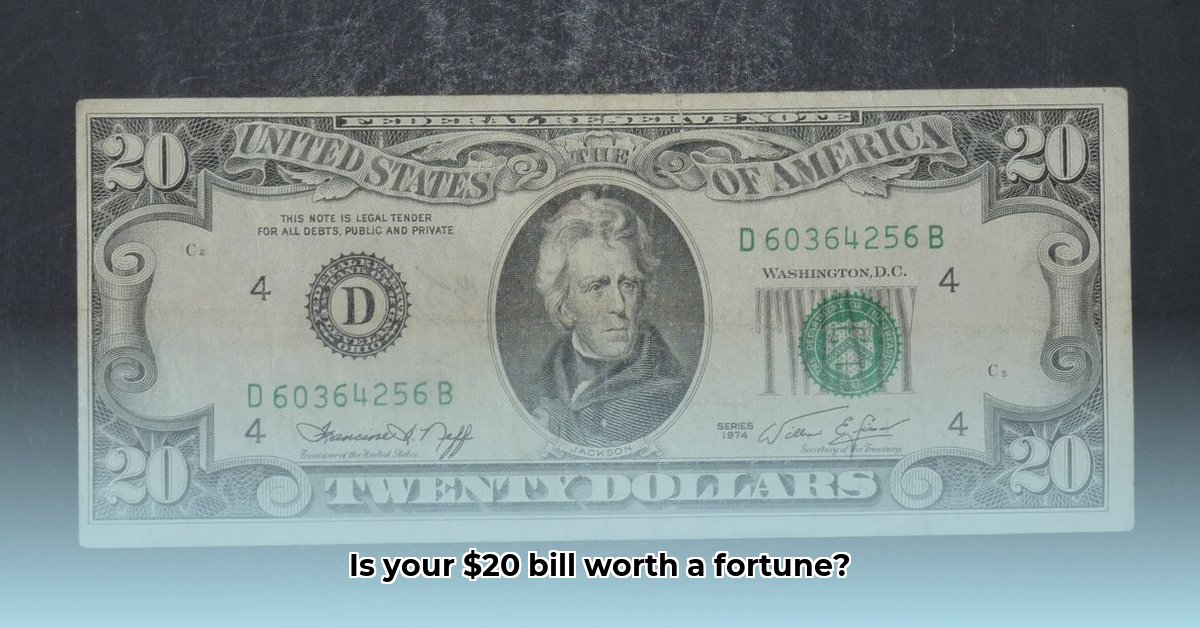
Value of a 1974 $20 Bill: Unearthing Hidden Treasure
Ever wondered if that old $20 bill tucked away in your drawer holds more than just face value? A 1974 twenty-dollar bill could be worth significantly more, depending on its condition and any unique features. For more information on older bills, check out this resource on 1963 $20 bills. This guide provides a step-by-step process to help you determine its true worth, whether you're a seasoned collector or just curious about your old currency.
Condition: The Cornerstone of Value
The condition of your 1974 $20 bill is paramount in determining its value. Just like a classic car, a pristine bill in "Gem Uncirculated" (perfect condition) will command a much higher price than a well-worn, circulated note. A crisp, uncreased bill, free from stains and tears, will be significantly more valuable than one showing signs of wear and tear. Conversely, a heavily circulated bill is likely only worth its face value. Numismatists (currency collectors) use grading scales, such as the widely recognized Sheldon Scale, to assign numerical grades that precisely reflect a bill's condition and value. A higher grade translates to a higher value. But how much higher? Could a 1974 $20 be worth thousands? It depends on the other factors discussed below.
Rare Features: Boosting Your Bill's Worth
Beyond condition, certain rare features can drastically increase a 1974 $20 bill's value. Let's explore some key features to look for:
Star Notes: Notice a star replacing a number in the serial number? This indicates a "star note," a replacement bill printed to correct a flaw in an original note. Their rarity increases their value considerably.
Low Serial Numbers: Bills with exceptionally low serial numbers (e.g., 00000001) are highly sought after. The lower the serial number, the rarer and more valuable the bill becomes. This is especially true for low serial number star notes.
Printing Errors: Occasional printing errors, such as misaligned images or missing elements, can dramatically increase a bill's value. These unique "misprints" are highly prized by collectors.
Issuing Federal Reserve Bank: The Federal Reserve Bank that issued the bill can also impact its value. Bills from certain banks might be scarcer than others, driving up their desirability among collectors. Is your twenty-dollar bill a hidden treasure? A careful examination will reveal the answer.
Determining the Value: A Step-by-Step Guide
This section lays out a structured process for assessing the value of your 1974 $20 bill. Follow these steps carefully to get the most accurate valuation:
Condition Assessment: Meticulously examine your bill for any imperfections: wrinkles, tears, stains, and any other signs of wear. Utilize online resources and grading guides to estimate its condition and assign a grade using a recognized scale like the Sheldon Scale.
Feature Identification: Carefully inspect the bill for star notes, low serial numbers, or printing errors. Document any unique features you discover.
Research and Comparison: Use online resources like eBay's completed listings, specialized numismatic websites, and auction records to find comparable 1974 $20 bills. Note their condition and features to get a sense of current market pricing for similar notes. Remember, prices vary widely depending on factors like the seller, buyer demand, and even the specific day of the sale.
Professional Grading (Optional): For bills suspected to be highly valuable, professional grading by a reputable numismatic organization is recommended. This offers authentication and precise valuation, bolstering the bill's credibility and marketability.
Value Spectrum and Considerations
The value of your 1974 $20 bill can range dramatically. While a typical circulated bill is worth $20, rare examples with exceptional condition and unique features can fetch hundreds, even thousands, of dollars. There's a wide range in terms of final pricing. Online auction sites offer a useful resource for market research. Consider the value a function of supply, demand and market conditions. However, keep in mind that the numismatic market constantly evolves, influencing prices. Remember that any valuation is an estimate, not a guaranteed price.
Beyond Monetary Value: A Piece of History
Your 1974 $20 bill represents a tangible piece of Americana. It’s a link to a bygone era, a snapshot of American history. Consider the fascinating journey this bill has undergone over nearly fifty years – all the hands it’s passed through, and the untold stories it could tell. This historical context adds to its intrinsic value, transcending its purely monetary worth.
Key Takeaways: Three Pivotal Points
Condition is Crucial: The pristine condition of your 1974 $20 bill drastically affects its value. A near-perfect bill (Gem Uncirculated) commands a premium.
Rarity Drives Value: Star notes, low-numbered bills, and printing errors significantly increase a bill's worth due to their rarity.
Professional Grading Matters: For high-value bills, professional grading ensures accurate assessment and bolsters the bill’s credibility in the market.